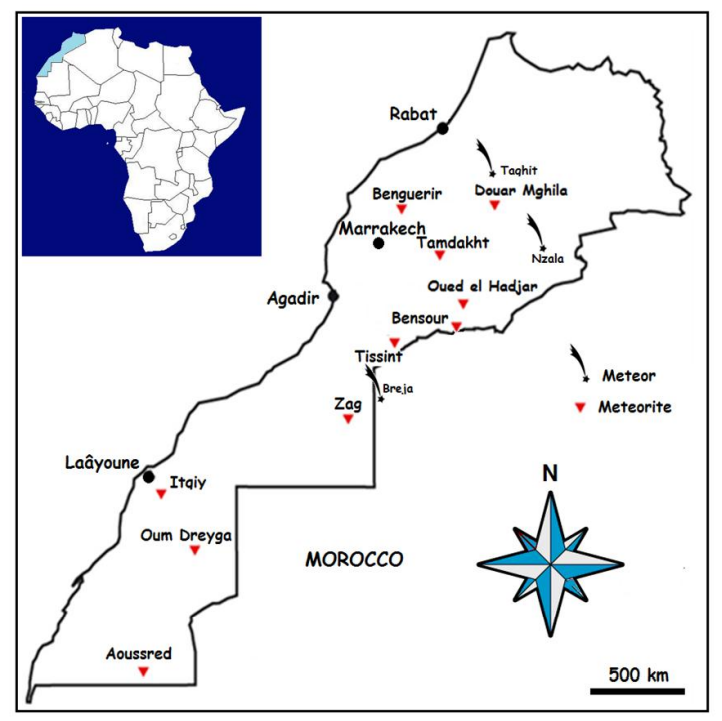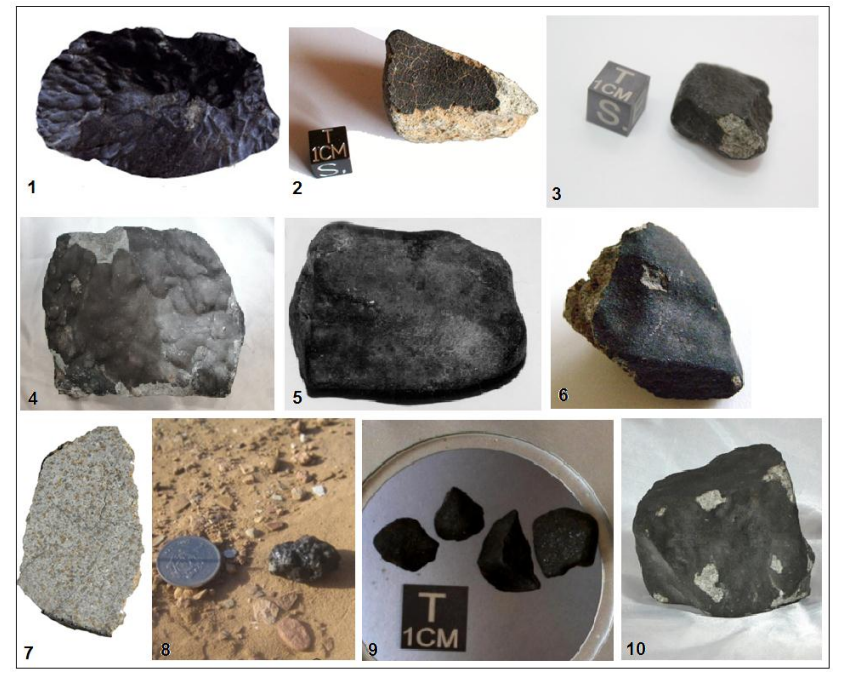Meteorite Falls in Morocco: A Scientific Window into the Cosmos
Introduction
Morocco’s vast deserts, clear skies, and minimal light pollution have long made it a paradise for astronomers and stargazers. But beyond the starry beauty above, the country’s unique geography has also made it one of the world’s most prolific regions for meteorite discoveries. From ancient space rocks scattered across the Sahara to bright fireballs witnessed by villagers and nomads, Morocco has forged a deep, growing connection with these cosmic messengers. This connection is not only cultural and scientific but also economic, as many locals participate in the collection and trade of these celestial fragments.
what are meteorites and meteors ?
To appreciate Morocco’s significance in meteorite research, it’s essential to understand the basics:
-
Meteors are small fragments of rock or metal from space that burn brightly as they enter Earth’s atmosphere. Commonly referred to as “shooting stars,” these flashes of light are actually the visible trails of debris vaporizing due to intense heat and friction.
-
If a meteor survives the plunge through the atmosphere and lands on Earth’s surface, it becomes known as a meteorite. These extraterrestrial rocks vary in composition ranging from iron-rich bodies to rare Martian and lunar specimens.

why is morocco a meteorite hotspot ?
Morocco’s contribution to global meteorite science is immense. Here’s why:
-
Ideal Terrain: The flat, dry landscapes of the Sahara Desert are optimal for meteorite recovery. Black or metallic meteorites stand out against the light-colored sands, making them relatively easier to locate than in forested or urban areas.
-
Active Local Participation: Moroccan nomads, often referred to as “meteorite finders,” play a crucial role. These experienced desert dwellers have sharp observational skills and intimate knowledge of the terrain, enabling them to locate freshly fallen meteorites—sometimes within hours of impact.
-
Global Scientific Interest: Moroccan meteorites are in high demand. Institutions such as NASA, European space agencies, and international universities acquire Moroccan specimens for research. This has positioned Morocco as a central node in the study of planetary science, especially when it comes to Martian and lunar meteorites.
Based on research by Moroccan geologist Prof. Abderrahmane Ibhi, several meteorite falls have been authenticated and geographically documented. His work highlights areas like Tissint, Bensour, Tamdakht, Oum Dreyga, and Aoussred, marking Morocco as a significant meteorite belt on the global map.

famous meteorite falls in morocco
Tissint (2011 – Shergottite – Martian Meteorite)
-
Location: Near Tissint, Tata Province, southeastern Morocco
-
Fall Date: July 18, 2011
-
Total Known Weight: ~12–15 kg
-
Type: Martian (Shergottite)
-
Event Details: A very bright fireball crossed the sky around 2 AM, followed by several sonic booms. Local nomads witnessed luminous flashes and loud explosions.
-
Scientific Importance: Tissint is one of the rare Martian meteorites with a witnessed fall. It contains trapped Martian atmosphere and signs of water-rock interaction, making it valuable for planetary science.
-
Interesting Fact: Fragments were quickly recovered, minimizing terrestrial contamination—important for geochemical studies of Mars.
Tamdakht (2008 – Ordinary Chondrite H5)
-
Location: Near Ouarzazate, High Atlas Mountains
-
Fall Date: December 20, 2008
-
Total Known Weight: ~100 kg
-
Type: Ordinary chondrite (H5)
-
Event Details: Seen from Agadir, Marrakesh, and Ouarzazate. The fireball lit the sky, followed by loud sonic booms and small aftershocks.
-
Recovery: Meteorite fragments were scattered over a wide area in a strewn field, with the largest piece weighing 30 kg.
-
Scientific Importance: Shows shock metamorphism and brecciation (fragmentation), providing insights into asteroid collisions.
Oum Dreyga (2003 – Ordinary Chondrite H3-5)
-
Location: Western Sahara, near Zbayra
-
Fall Date: October 16, 2003
-
Total Known Weight: ~17 kg
-
Type: Ordinary chondrite (H3-5 breccia)
-
Event Details: Moroccan military personnel observed the meteor falling near the defensive wall known as the “Berm”.
-
Recovery: Collected under difficult conditions due to military activity and minefields.
-
Scientific Importance: A rare breccia combining different types of H chondrites. The mix of lithologies is valuable for understanding asteroid evolution.
Bensour (2002 – Ordinary Chondrite LL6)
-
Location: Border region of Morocco and Algeria
-
Fall Date: February 11, 2002
-
Total Known Weight: ~45 kg
-
Type: Ordinary chondrite (LL6)
-
Event Details: Eyewitnesses saw a bright fireball and multiple meteorites falling, but reports were imprecise.
-
Largest Fragment: ~9.2 kg, which broke into three upon impact.
-
Scientific Importance: Its well-preserved fusion crust and freshness make it ideal for petrological studies.
-
Note: LL6 chondrites are rare, meaning they have low metal content and experienced high thermal metamorphism.
Zag (1998 – Ordinary Chondrite H3-6)
-
Location: Near Zag, southern Morocco
-
Fall Date: August 4, 1998
-
Total Known Weight: ~175 kg
-
Type: Ordinary chondrite (H3-6 breccia)
-
Event Details: Locals reported a fireball over mountainous terrain. Multiple pieces were found under different names (Zag, Sagd, Tan-Tan).
-
Scientific Importance: One of the most chemically diverse meteorites. Contains pre-solar grains and unusual inclusions, including halite (salt) possibly formed in the early solar system.
-
Notable: Important in the study of water-bearing materials in asteroids.
Breja (2010 – Ordinary Chondrite LL6)
-
Location: Border near Tindouf, east of Zag
-
Fall Date: May 1, 2010
-
Total Known Weight: Unknown
-
Type: Ordinary chondrite (LL6)
-
Event Details: A powerful bolide lit up the sky around 3:00 GMT, followed by a loud sonic boom. Witnesses reported seeing fragmentation.
-
Recovery: Recovered by nomads near the Algerian-Moroccan border.
-
Scientific Importance: LL6 classification suggests thermal processing on its parent body.
Nzala (2009 – Ordinary Chondrite)
-
Location: Near Erfoud, Errachidia
-
Fall Date: November 13, 2009
-
Total Known Weight: ~800 grams (only 2 fragments)
-
Event Details: Seen over a large region; three sonic booms heard. However, the search was mostly unsuccessful.
-
Scientific Importance: Because of the rarity of samples, not widely studied.
-
Challenge: Eyewitnesses gave vague coordinates; only two samples reported from nomads.
Taouz (2010 – No Sample Recovered Yet)
-
Location: Taouz region, southeastern Morocco
-
Fall Date: May 19, 2010
-
Event Details: A very bright meteor seen at 4:00 GMT. Observers reported loud sounds like rocks falling.
-
Eyewitnesses: Also confirmed from Taghit, Algeria, at the same time.
-
Scientific Challenge: Despite reports, no verified fragments have been recovered to date.
famous meteor events in morocco
Here is a collection of notable meteorite specimens discovered in Morocco ideal for visually enriching your article on meteor-related phenomena in the country
The falls of Breja, Nzala and Taouz by opposition to the other witnessed falls, raises a problem in the exactness of the statements which relate to it. Despite eyewitnesses’ presence, it always misses in the declaration of this fall the essential elements as the exact coordinates and even the precise day of the fall. As the meteors observations are not precise, the research is not always successful, and they can spend weeks and months in the field without recovering the meteorite. While there will always be an element of luck involved in International Letters of Chemistry, Physics and Astronomy 12 (2013) 28-35 33 meteorite fall recovery, a nighttime fireball, after all, will be visible over a much larger geographical region than that in which the meteorite physically falls.

Breja (2010, LL6 ordinary chondrite)
May 1st at 3:00 GMT around Breja, 35km north of Tindouf and east of Zag, many people witnessed a very bright bolide accompanied by a sonic boom and fragmentation event. Nomads recovered the meteoritic material in the border to Morocco.
Nzala (2009, Ordinary chondrite)
November 13th at 21:00 GMT, many people from Erfoud, Errachidia and Errich (Morocco) observed the meteor and heard three sonic booms. Meteorite hunters searched for weeks but no sample has been found except one report from a dealer about nomads who found two pieces of about 100 and 700 grams.
Taouz (2010, no sample has been recovered so far)
May 19th at 4:00 GMT. In Taouz area, a few eyewitnesses reported the high brightness meteor and a sound like many rocks fall. At the same date and hour, people from Taghit in Algeria reported a similar observation. Below is complete list of the well documented meteorite falls, showing the name of the meteorite, the date it fell, the place of fall, and the type of meteorite. Also, meteors are named after the place they fell.
conclusion
Morocco’s skies and deserts are a remarkable gateway to the cosmos, offering not only stunning views of stars and meteor showers but also a treasure trove of meteorites that have landed on its soil. These celestial visitors ranging from spectacular fireballs lighting up the night sky to rare fragments from Mars connect us directly to the history and mysteries of our solar system. Whether you’re a scientist, an astronomy enthusiast, or a curious traveler, Morocco’s meteorite heritage invites you to explore and appreciate the universe in a truly unique way.
